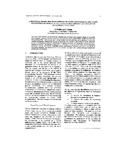| dc.contributor.author | Mothibi, J. | |
| dc.contributor.author | Kutua, S. | |
| dc.date.accessioned | 2011-06-03T10:25:11Z | |
| dc.date.available | 2011-06-03T10:25:11Z | |
| dc.date.issued | 2001 | |
| dc.identifier.citation | Mothibi, J.& Kutua, S. (2001) A practical model for development of viable engineering education institutions in Africa: with a focus on management and quality of engineering education, Botswana Journal of Technology, Vol. 10, No. 2, pp. 61-66 | en_US |
| dc.identifier.issn | 1019 1593 | |
| dc.identifier.uri | http://hdl.handle.net/10311/825 | |
| dc.description.abstract | One of the critical elements that determine the competitiveness of nations is the population density of, and quality of its engineers. This view has been corroborated by researchers such as Biluch (1989), Garelli et al (1997), and Gharajedaghi (1986). Unfortunately most African countries are not performing well on this front. Engineering education institutions, entrusted with the task of improving the measures, find themselves in the uneviable position of attempting to operate in environments in which governments are continuously reducing funding to education in general. The objective of this paper is to develop conceptual models which can aid engineering institution overcome the financial constraints, increase throughput of engineers, and improve the quality of engineering education. The model is based on the cybernetics paradigm and is validated through structural and multiplicative corroboration. | en_US |
| dc.language.iso | en | en_US |
| dc.publisher | University of Botswana, www.ub.bw | en_US |
| dc.subject | engineering education | en_US |
| dc.subject | Africa engineering education | en_US |
| dc.title | A practical model for development of viable engineering education institutions in Africa: with a focus on management and quality of engineering eduation | en_US |
| dc.type | Published Article | en_US |

